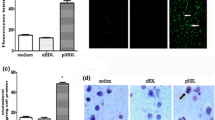Abstract
CXC chemokine family has been related to atherogenesis for long. However, the relationship between CXCL14 and atherogenesis is still unclear. This study preliminarily detected CXCL14 expression at foam cells in atherosclerosis specimens by immunohistochemistry. In vitro foam cells were derived from THP-1 after phorbol-12-myristate-13-acetate (PMA) and oxidized low-density lipoprotein (ox-LDL) stimulation. Immunoblotting and qPCR convinced CXCL14 expression variation during foam cell formation. We further demonstrated that ox-LDL regulated CXCL14 expression by AP-1. AP-1 could bind to CXCL14 promoter and up-regulate CXCL14 mRNA expression. Besides, CXCL14 promoted THP-1 migration, macrophage lipid phagocytosis, and smooth muscle cell migration as well as proliferation mainly via the ERK1/2 pathway. Additionally, a CXCL14 peptide-induced immune therapy showed efficacy in ApoE−/− mouse model. In conclusion, our study demonstrated that CXCL14 is highly up-regulated during foam cell formation and promotes atherogenesis in various ways. CXCL14 may be a potent therapeutic target for atherosclerosis.





Similar content being viewed by others
References
Ference, B. A., Ginsberg, H. N., Graham, I., et al. (2017). Low-density lipoproteins cause atherosclerotic cardiovascular disease. 1. Evidence from genetic, epidemiologic, and clinical studies. A consensus statement from the European Atherosclerosis Society Consensus Panel.[J]. European Heart Journal, 38, 2459–2472.
Cao Dian, J. (2018). Macrophages in cardiovascular homeostasis and disease.[J]. Circulation, 138, 2452–2455.
Tabas, I., & Lichtman, A. H. (2017). Monocyte-macrophages and T cells in atherosclerosis.[J]. Immunity, 47, 621–634.
Puca, A. A., Carrizzo, A., Spinelli, C., et al. (2019). Single systemic transfer of a human gene associated with exceptional longevity halts the progression of atherosclerosis and inflammation in ApoE knockout mice through a CXCR4-mediated mechanism.[J]. European Heart Journal published ahead of time.
Li, X., Kemmer, L., Zhang, X., et al. (2018). Anti-inflammatory effects on atherosclerotic lesions induced by CXCR4-directed endoradiotherapy.[J]. Journal of the American College of Cardiology, 72, 122–123.
Sainz, J., & Sata, M. (2007). CXCR4, a key modulator of vascular progenitor cells.[J]. Arteriosclerosis, Thrombosis, and Vascular Biology, 27, 263–265.
Merckelbach, S., van der Vorst, E. P. C., Kallmayer, M., et al. (2018). Expression and cellular localization of CXCR4 and CXCL12 in human carotid atherosclerotic plaques.[J]. Thrombosis and Haemostasis, 118, 195–206.
Salogni, L., Musso, T., Bosisio, D., et al. Activin A induces dendritic cell migration through the polarized release of CXC chemokine ligands 12 and 14. Blood, 113(23), 5848–5856.
Lu, J., Chatterjee, M., Schmid, H., et al. CXCL14 as an emerging immune and inflammatory modulator. Journal of Inflammation (Lond)., 13, 1.
Sleeman, M. A., Fraser, J. K., Murison, J. G., Kelly, S. L., et al. B cell- and monocyte-activating chemokine (BMAC), a novel non-ELR alphachemokine. International Immunology, 12(5), 677–689.
Frederick, M. J., Henderson, Y., et al. In vivo expression of the novel CXC chemokine BRAK in normal and cancerous human tissue. The American Journal of Pathology, 156(6), 1937–1950.
Kurth, I., Willimann, K., Schaerli, P., et al. Monocyte selectivity and tissue localization suggests a role for breast and kidney-expressed chemokine (BRAK) in macrophage development. The Journal of Experimental Medicine, 194(6), 855–861.
Ozawa, S., Kato, Y., Komori, R., et al. BRAK/CXCL14 expression suppresses tumor growth in vivo in human oral carcinoma cells. Biochemical and Biophysical Research Communications, 348(2), 406–412.
Tessema, M., Klinge, D. M., Yingling, C. M., et al. Re-expression of CXCL14, a common target for epigenetic silencing in lung cancer, induces tumor necrosis. Oncogene., 29(37), 5159–5170.
Song, E. Y., Shurin, M. R., Tourkova, I. L., et al. Epigenetic mechanisms of promigratory chemokine CXCL14 regulation in human prostate cancer cells. Cancer Research, 70(11), 4394–4401.
Nara, N., Nakayama, Y., Okamoto, S., et al. (2007). Disruption of CXC motif chemokine ligand-14 in mice ameliorates obesity-induced insulin resistance.[J]. The Journal of Biological Chemistry, 282, 30794–30803.
Tanegashima, K., Suzuki, K., Nakayama, Y., et al. (2010). Antibody-assisted enhancement of biological activities of CXCL14 in human monocytic leukemia-derived THP-1 cells and high fat diet-induced obese mice.[J]. Experimental Cell Research, 316, 1263–1270.
Poon, W.-L., Alenius, H., Ndika, J., et al. (2017). Nano-sized zinc oxide and silver, but not titanium dioxide, induce innate and adaptive immunity and antiviral response in differentiated THP-1 cells.[J]. Nanotoxicology, 11, 936–951.
Pelicano, H., et al. Mitochondrial dysfunction and reactive oxygen species imbalance promote breast cancer cell motility through a CXCL14-mediated mechanism. Cancer Research, 69(6), 2375–2383.
Foncea, R., Mazière, C., et al. Endothelial cell oxidative stress and signal transduction. Biological Research, 33(2), 89–96.
Suxia, M., Zhifeng, B., et al. The DPP-4 inhibitor saxagliptin ameliorates ox-LDL-induced endothelial dysfunction by regulating AP-1 and NF-κB. European Journal of Pharmacology, 851, 186–193.
Sterner, R. M., Takahashi, P. Y., Yu, B., & Aimee, C. (2016). Active vaccines for Alzheimer disease treatment.[J]. Journal of the American Medical Directors Association, 17, 862.e11–862.e15.
Funding
This study was supported in part by research grants 81770263, 81570254, and 31271040 from the National Natural Science Foundation of China.
Author information
Authors and Affiliations
Contributions
W.T., R.Y., C.P., and Y.W. conducted the experiments. Y.D. analyzed the results. W.T. wrote the manuscript. Z.H. and G.W. conceived the experiments. All authors reviewed the manuscript.
Corresponding authors
Ethics declarations
All experimental protocols were approved by the Ethical Committee of Tongji Hospital, Tongji Medical College, Huazhong University of Science and Technology. All animal studies were performed in accordance with the Guidelines of the Hubei Council of Animal Care and approved by the Experimental Animal Committee of the Huazhong University of Science and Technology in China. The informed consent was obtained from all subjects, and this study is approved by the Ethical Committee of Tongji Hospital, Tongji Medical College, Huazhong University of Science and Technology.
Competing Interests
The authors declare that they have no competing interests.
Additional information
Associate Editor Nicola Smart oversaw the review of this article.
Publisher’s Note
Springer Nature remains neutral with regard to jurisdictional claims in published maps and institutional affiliations.
Rights and permissions
About this article
Cite this article
Tong, W., Duan, Y., Yang, R. et al. Foam Cell-Derived CXCL14 Muti-Functionally Promotes Atherogenesis and Is a Potent Therapeutic Target in Atherosclerosis. J. of Cardiovasc. Trans. Res. 13, 215–224 (2020). https://doi.org/10.1007/s12265-019-09915-z
Received:
Accepted:
Published:
Issue Date:
DOI: https://doi.org/10.1007/s12265-019-09915-z




